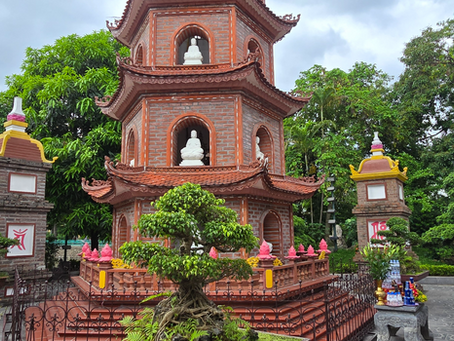top of page

GLOBAL SHANANIGANS

Search


The Legacy of Trấn Quốc Pagoda
With its origins stretching back over 1500 years, Trấn Quốc Pagoda holds the distinction of being the oldest Buddhist temple in the country. It was originally built around 545 AD during the reign of Emperor Lý Nam Đế, who commissioned its construction as part of a broader vision to legitimise Vietnamese sovereignty in the midst of political upheaval and resistance against Chinese rule.
Shannon


Trúc Lâm Phật Tích Bản Giốc Pagoda
Perched on the forested slopes of Phia Nham Mountain in northern Vietnam’s Cao Bằng Province, this pagoda complex is a spiritual beacon overlooking the breathtaking Bản Giốc Waterfall. Officially inaugurated in December 2014, the pagoda holds the distinction of being the first Buddhist temple built along the northern border of Vietnam.
Shannon


The Legacy of King Lê Thái Tổ
This quiet and understated shrine on the southeastern banks of Hoàn Kiếm Lake pays homage to King Lê Thái Tổ, the revered 15th-century General-turned-Emperor. He liberated Vietnam from Chinese rule and founded the Later Lê Dynasty, the country's longest ruling imperial line. Built in 1894, the Lê King Temple is a quiet portal into Vietnam’s post-colonial rebirth, layered with political significance and tales of divine destiny, rebellion and the enduring power of myth.
Shannon


Beneath the Dragon - Imperial Citadel of Thăng Long
Constructed on the remains of a 7th century Chinese fortress, the Thăng Long Imperial Citadel was built on strategic reclaimed river lands on the lower Red River Delta and for nearly 13 centuries, remained the regional powerhouse of Northern Vietnamese political & military domination. Shortly after his ascension to the throne, Emperor Lý Thái Tổ declared a royal decree in the year 1010, to move the capital from Hoa Lư and establish a new Imperial City for the Lý Dynasty.
Shannon


Quan Thanh Temple and The Dark God of Hanoi
Perched at the edge of Hanoi’s scenic West Lake, Quán Thánh stands as one of Vietnam’s most venerable Taoist temples. Believed to have been founded during the reign of Emperor Lý Thái Tổ in the 11th century, the temple was originally built to honour Trấn Vũ, the feared & revered Taoist deity known as the “Guardian of the North".
Shannon


The Marble Mountains
Just south of Da Nang on Vietnam’s central coast, the Marble Mountains (Ngu Hành Sơn) rise like ancient sentinels above the surrounding flatlands. These five striking limestone and marble hills are each named after one of the five elements of Eastern philosophy: metal (Kim), wood (Mộc), water (Thủy), fire (Hỏa) and earth (Thổ). Steeped in legend and spirituality, the mountains have long served as places of worship and retreat.
Shannon


Huế’s Last Empire - The Rise and Ruin of the Imperial Citadel
In 1777, the Nguyen clan was extinguished in a brutal massacre that marked the end of their reign, save for one, a fifteen-year-old boy named Nguyen Phuc Anh. Orphaned and on the run, he hid in the southern reaches of Vietnam, surviving betrayal, jungle sickness and assassins sent by the rival Tay Son brothers. Legend tells of a mysterious hermit who gave the boy refuge in the sacred mountains of Thien Thai, prophesying that the boy would reclaim his bloodline and raise an em
Shannon


The Royal Tomb of Emperor Minh Mạng
Nestled along the banks of the Perfume River in the southwest corner of Hué, King Minh Mạng’s funeral complex was the result of a grand vision and an extensive building program. Guided by the ancient practice of geomancy, which aligns structures with natural forces, the complex was designed to harmonise with the environment, blending the spiritual with the earthly.
Shannon


The Green Sea of Tam Cốc
This UNESCO World Heritage area, also known as Halong Bay on land, stretches along the Ngo Dong River and is flanked by views of majestic karst cliffs, limestone caves, grottoes, and vibrant green rice fields. Tam Cốc literally translates to “three caves,” referring to the Ca, Hai and Ba caves carved by centuries of flowing water. Locals often refer to the surrounding fields as the Green Sea, a poetic nod to the way the wind ripples through the endless rice paddies like waves
Shannon


Vính Tráng Pagoda - A Survivor of War and Time
Originally established in the early 19th century as a humble hermitage tucked beneath the shade of dense tropical foliage, Vĩnh Tràng...
Shannon


The Mausoleum of Khai Dinh - The Puppet King
Leaning against the Chau Chu Mountain in the outskirts of Hue, this elaborately designed, hillside tomb has elements of Vietnamese and European architectural styles. Featuring blackened concrete, the Gothic inspired monument casts a striking silhouette against the verdant green countryside. While comparatively smaller than other Royal tombs, the building itself is far more elaborately designed than others of its era.
Shannon


Hoa Lư - The Ancient Capital
Located south of the Red River Delta Region 90 km's from Hanoi, Hoa Lư was a bustling capital city in turmoil during the 10th and 11th centuries. For a short time, it was the economic, political and cultural centre of medieval Vietnam. In 968 A.D, it was strategically built in a flat verdant valley, protected between steep limestone mountains, which created a virtually impenetrable barrier to human traffic.
Shannon
bottom of page